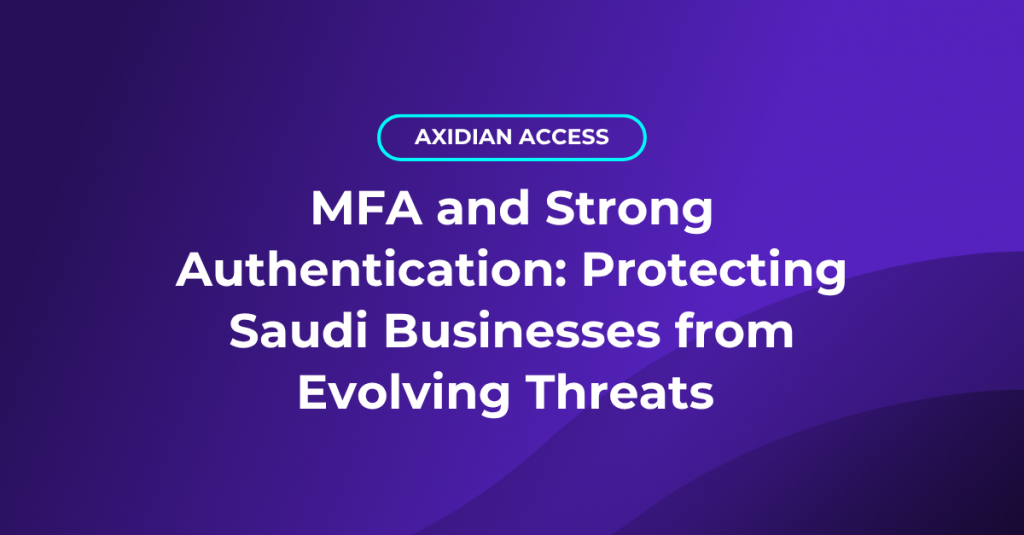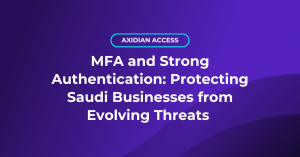Cyberattacks are rising across the GCC, and stolen credentials remain one of the top breach vectors. For example, according to CPX, the average cost of a data breach in the Middle East rose to approximately US$8 million in 2024.
In this article, we explain what strong authentication is, why it’s crucial in 2025, and how solutions like Axidian Access help organizations in Saudi Arabia meet compliance requirements and stop unauthorized access before it happens.
Strong Authentication — The Basics
Strong authentication is the process of verifying a user’s identity using more than one independent factor, typically from these categories:
- Something the user knows (like a password or PIN)
- Something the user has (such as a smartphone, token, or smartcard)
- Something the user is (biometrics like fingerprint or facial recognition)
This layered approach protects against common threats like phishing, credential theft, and brute-force attacks. Even if one factor is compromised, attackers can’t easily break through.
Why Strong Authentication Is Critical in 2025
In today’s environment, credentials are one of the easiest targets for attackers. With password reuse, phishing, and social engineering on the rise, relying on traditional logins is no longer safe. Strong authentication significantly reduces this risk by requiring more than just a password. It adds independent layers of verification that are much harder to compromise.
This becomes even more critical as remote access becomes the norm. Employees, partners, and third-party vendors now connect from various devices and locations. Strong authentication ensures that only authorized users — regardless of where they are — can access sensitive systems.
Beyond security, compliance is also a key driver. In Saudi Arabia, frameworks like NCA ECC or SAMA, along with international standards such as ISO 27001, mandate strict access control. Implementing strong authentication directly supports these requirements, making audit preparation smoother and reducing the risk of non-compliance.
The financial and reputational impact of a breach is higher than ever. A single compromised account can lead to full-scale infrastructure exposure. By serving as a scalable and proactive security measure, strong authentication helps organizations minimize risk before incidents occur.
MFA vs. Strong Authentication — What’s the Difference?
While Multi-Factor Authentication (MFA) is a practical way to implement strong authentication, strong authentication is a broader concept. It emphasizes:
- Zero reliance on shared secrets (like passwords)
- Stronger resistance to phishing
- Hardware-backed or biometric identity verification
Solutions like Axidian Access offer strong authentication mechanisms including MFA enabling organizations to protect identities with secure login flows, biometric support, and RFID cards.
Examples of Strong Authentication in Action
There’s no one-size-fits-all method for strong authentication and that’s the point. Different industries, systems, and risk levels require different approaches. Below are common methods used to implement strong authentication, each with its own strengths:
One-Time Passwords (OTP)
Time-sensitive codes sent via SMS, email, or authenticator apps like Google Authenticator. OTPs are widely adopted due to their simplicity and ease of deployment. They add an additional layer beyond the static password but can still be vulnerable to phishing if not combined with other methods.
Biometric Authentication
Biometrics such as fingerprint scans, facial recognition, or iris detection are tied to something the user is. These methods offer high assurance because they’re unique and hard to replicate. However, biometric data must be stored and processed securely, as it’s irreplaceable if compromised.
App-Generated Codes
Authenticator apps like Microsoft Authenticator or Duo Mobile generate rotating codes locally on a user’s device, offering more protection than SMS. Since codes aren’t transmitted over the network, they’re more resistant to interception.
Hardware Security Keys
USB tokens (e.g., YubiKeys) or smart cards use cryptographic protocols to prove user identity. These are among the most secure forms of authentication — resistant to phishing, replay, and man-in-the-middle attacks. They require physical possession, making attacks much harder to automate.
Push Notification Approvals
When a user logs in, a push notification is sent to a registered device for quick approval. This combines convenience and security. If someone attempts unauthorized access, the real user is instantly alerted.
Location-Based Authentication
If a login is attempted from an unusual or high-risk location, additional verification steps are triggered. This adds contextual awareness and helps identify suspicious behavior early.
Certificate-Based Authentication
This method uses digital certificates issued to devices or users to confirm identity. Often used in enterprise environments, it supports secure messaging, encrypted connections, and machine authentication.
Best Practices for Implementing Strong Authentication
To get the most out of strong authentication, organizations need more than just technology — they need thoughtful implementation. Here’s how to approach it strategically:
1. Apply risk-based access control
Not every user needs the same level of authentication. A role-based or risk-based access strategy ensures that users working with critical systems, like finance, admin consoles, or privileged accounts, face stronger verification methods, such as biometrics or hardware tokens. Meanwhile, everyday business users can log in with lighter MFA, maintaining balance between usability and security.
This approach reduces friction without compromising protection and ensures that your most valuable assets aren’t protected by just a password.
2. Eliminate passwords wherever possible
Passwords are still the weakest link. They get reused, guessed, phished, and stolen. Strong authentication works best when you replace passwords entirely with modern alternatives like biometrics, mobile push approvals, or FIDO2-compliant hardware keys.
Solutions like Axidian Access support passwordless login flows and enabling fast, secure access while reducing attack surface and help desk load.
3. Invest in user education
Even the strongest systems can be undermined by human error. Teach users how to recognize phishing attempts, protect authentication devices (like phones or tokens), and understand why layered verification matters. Security should feel like part of the workflow, not a blocker.
Informed users are more likely to follow best practices and less likely to fall for social engineering attacks.
4. Monitor and audit authentication events
Authentication logs aren’t just for compliance. They’re essential for incident response. Keep detailed records of who accessed what, when, and how. Use anomaly detection to flag login attempts from suspicious locations, devices, or times.
With Axidian Access, you can track access patterns and investigate anomalies before they become breaches.
5. Align authentication methods to compliance and business goals
Regulations like NCA ECС or ISO 27001, often require strong, multi-factor authentication. But the real value comes when your authentication strategy supports business growth — enabling secure remote work, partner collaboration, and cloud adoption without slowing things down.
That means selecting authentication methods that fit your infrastructure, meet user expectations, and grow with your security roadmap.
Strong Authentication with Axidian Access
Axidian Access supports a wide range of authentication methods — from MFA and OTP to biometrics and certificate-based login — helping your organization implement strong, adaptable security for every user and system.
It integrates smoothly with your existing IT and compliance stack, so you can secure identities without slowing down workflows. Whether you’re working toward NCA ECC readiness or expanding Zero Trust, Axidian Access has the tools to help.
Strong authentication is no longer optional. In Saudi Arabia, where compliance and breach prevention go hand in hand, solutions like Axidian Access are essential to building trust and resilience.
Want to see it in action? Book a demo with our team or follow us on LinkedIn for updates and expert insights.



